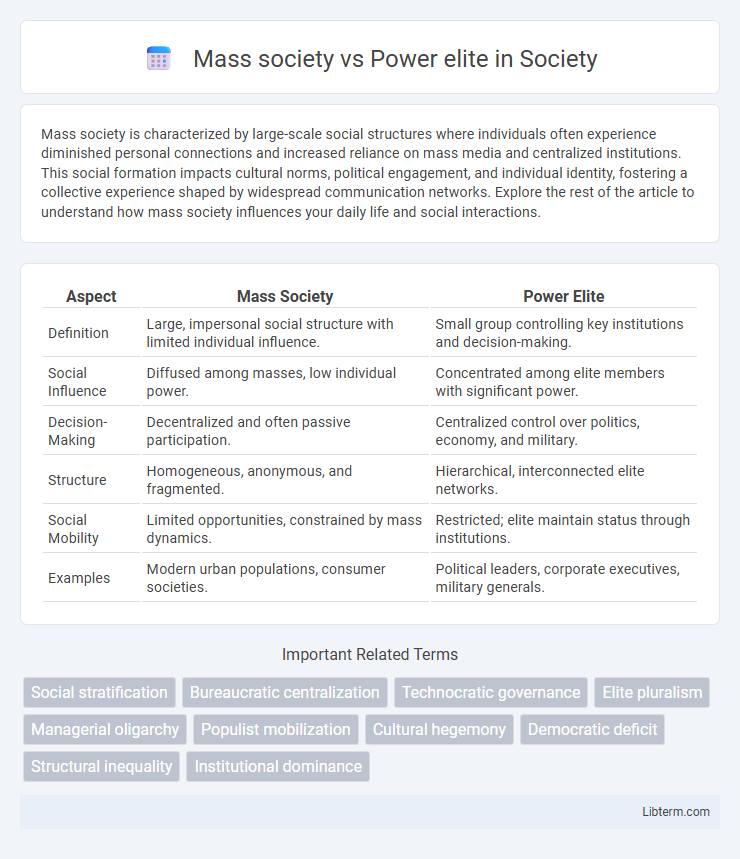Mass society is characterized by large-scale social structures where individuals often experience diminished personal connections and increased reliance on mass media and centralized institutions. This social formation impacts cultural norms, political engagement, and individual identity, fostering a collective experience shaped by widespread communication networks. Explore the rest of the article to understand how mass society influences your daily life and social interactions.
Table of Comparison
| Aspect | Mass Society | Power Elite |
|---|---|---|
| Definition | Large, impersonal social structure with limited individual influence. | Small group controlling key institutions and decision-making. |
| Social Influence | Diffused among masses, low individual power. | Concentrated among elite members with significant power. |
| Decision-Making | Decentralized and often passive participation. | Centralized control over politics, economy, and military. |
| Structure | Homogeneous, anonymous, and fragmented. | Hierarchical, interconnected elite networks. |
| Social Mobility | Limited opportunities, constrained by mass dynamics. | Restricted; elite maintain status through institutions. |
| Examples | Modern urban populations, consumer societies. | Political leaders, corporate executives, military generals. |
Understanding Mass Society: Key Characteristics
Mass society is characterized by large, impersonal social structures where individuals experience diminished social bonds and increased isolation, leading to widespread conformity and loss of traditional community ties. It features centralized institutions and mass media that shape public opinion and cultural norms, often resulting in homogenization of beliefs and behaviors. The mass society framework highlights the vulnerability of individuals to manipulation by elite groups who control these dominant institutions.
Defining the Power Elite: Who Are They?
The power elite consists of a small group of influential individuals who hold dominant positions in political, corporate, and military institutions, shaping major societal decisions and policies. This elite wields concentrated power, often operating beyond public scrutiny and democratic accountability. Their interconnected roles enable them to maintain control over economic resources, governmental authority, and social norms, distinguishing them sharply from the dispersed masses in mass society.
Historical Origins of Mass Society Theory
The historical origins of mass society theory trace back to the rapid industrialization and urbanization of the 19th and early 20th centuries, which transformed traditional social structures into large, impersonal societies. Thinkers like Ferdinand Tonnies and Emile Durkheim highlighted the shift from Gemeinschaft (community) to Gesellschaft (society), emphasizing the rise of bureaucratic institutions and weakened social ties. This transformation set the stage for critiques of mass society that contrasted it with the concentrated influence of the power elite, who control political, military, and economic institutions within these vast social structures.
Evolution of the Power Elite Concept
The evolution of the power elite concept, primarily developed by sociologist C. Wright Mills in the 1950s, highlights the concentration of power among a small group of military, corporate, and political leaders, contrasting sharply with the decentralized and homogenized nature of mass society. Unlike mass society theories that emphasize conformity and the influence of mass culture, the power elite framework underscores hierarchical structures where decision-making is centralized and elite-driven. Over time, scholars have expanded this concept to include globalized networks of economic and political power, reflecting changes in institutional and technological contexts.
Mass Society and Social Control Mechanisms
Mass society refers to a large, impersonal social structure characterized by weakened traditional social bonds and increased isolation among individuals. Social control mechanisms in mass societies often rely on formal institutions such as laws, media, and surveillance to maintain order and regulate behavior. The erosion of community ties in mass societies amplifies dependence on these external controls to sustain social stability and prevent disorder.
Power Elite: Influence on Policy and Decision-Making
The power elite, consisting of top leaders in politics, business, and military, exert significant influence on policy and decision-making through their interconnected control over key institutions. Their ability to shape public agendas, direct economic resources, and dominate media narratives ensures that policy outcomes often reflect elite interests rather than mass society demands. This concentration of power undermines democratic participation by marginalizing broader public input in critical governance processes.
The Relationship Between Mass Society and the Power Elite
The relationship between mass society and the power elite is characterized by the concentration of decision-making authority within a small, influential group, which shapes societal norms and policies while the larger population remains largely passive or disengaged. Mass society, defined by its homogenized culture and diminished social ties, facilitates the power elite's control by reducing individual autonomy and critical resistance. This dynamic creates a feedback loop where the power elite maintain dominance through mass media and institutional mechanisms, reinforcing social stratification and limiting democratic participation.
Media’s Role: Shaping Mass Perceptions and Elite Narratives
The media functions as a powerful tool in shaping mass perceptions by disseminating information that often reflects the interests and perspectives of the power elite. Mass society consumes media content that reinforces dominant narratives, subtly aligning public opinion with elite agendas through selective coverage and framing techniques. This dynamic creates a feedback loop where media both constructs and perpetuates social hierarchies by privileging elite voices while marginalizing alternative viewpoints.
Case Studies: Mass Society vs. Power Elite in Action
Case studies of mass society versus power elite reveal stark contrasts in decision-making dynamics and societal influence. The 1960s U.S. civil rights movement illustrates mass society mobilization challenging entrenched power elites, whose resistance highlights control over political and economic resources. In contrast, studies of corporate lobbying demonstrate how power elites strategically shape policy outcomes, often sidelining mass public interests to maintain systemic dominance.
Future Implications: Democracy, Participation, and Change
Mass society theory suggests that increased social isolation and cultural homogenization may weaken democratic participation by fostering apathy and conformity, while the power elite model emphasizes how concentrated authority in a small group can limit genuine democratic change. Future implications include risks of diminished citizen engagement and the entrenchment of elite interests, potentially undermining democratic accountability and innovation. To counter these challenges, enhancing transparency, decentralizing decision-making, and promoting inclusive participation are critical for sustaining vibrant, adaptive democratic systems.
Mass society Infographic

 libterm.com
libterm.com